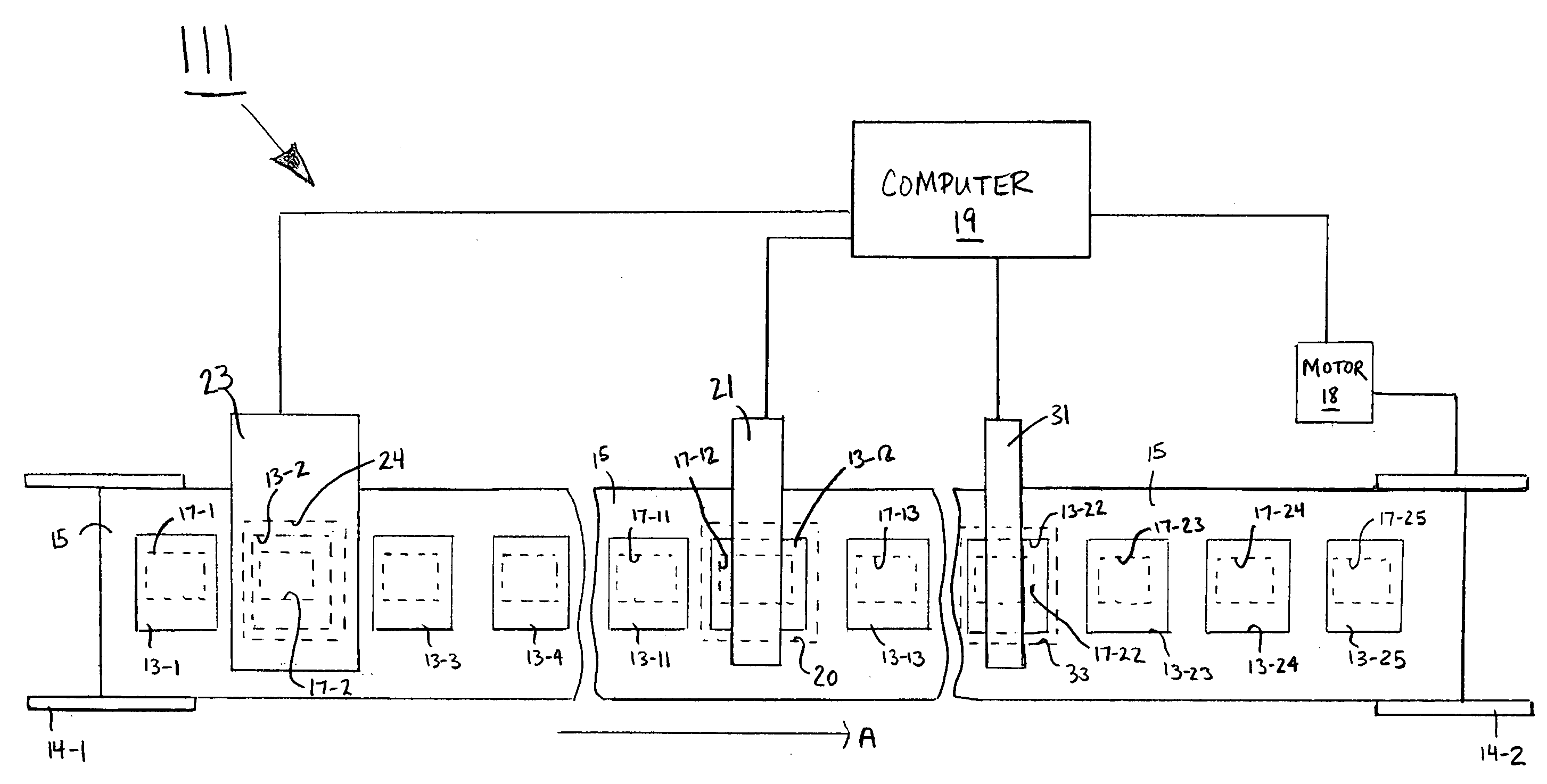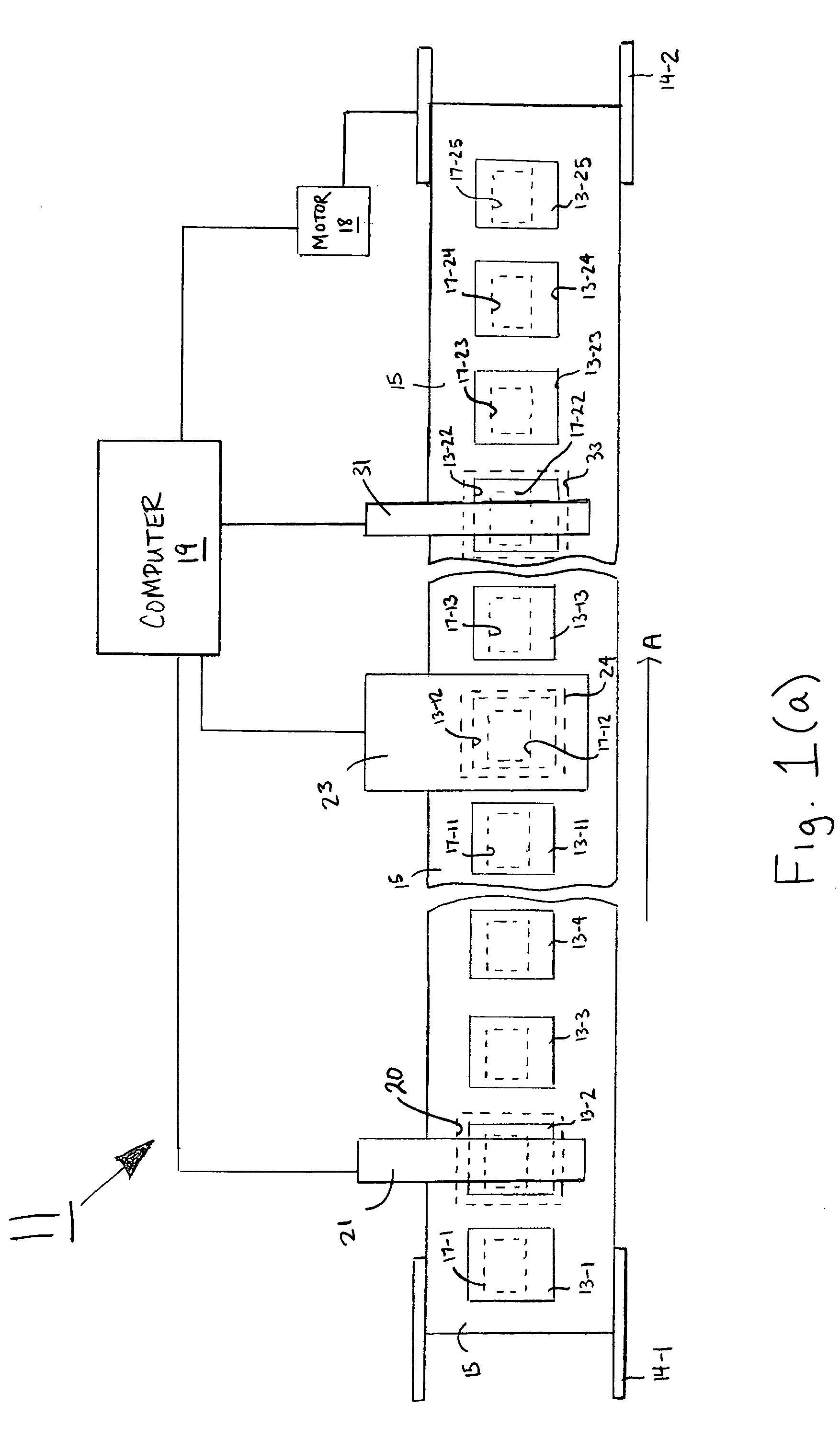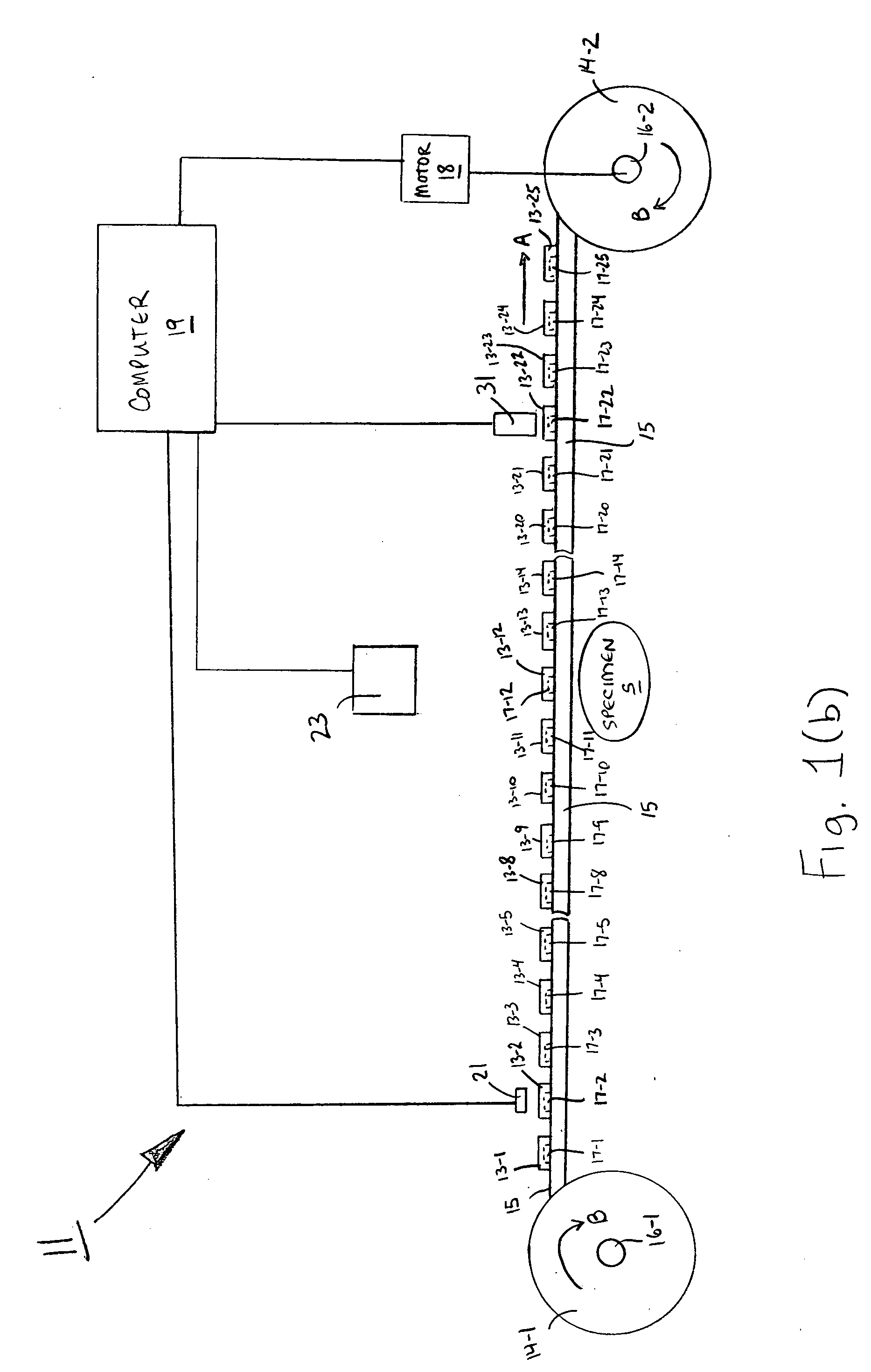[0013] Therefore, according to one aspect of the invention, there is provided a system for testing at least one of a plurality of RFID devices spaced closely together, said system comprising (a) a short-range tester for reading / writing a unique identifier for an RFID device positioned at a short-range testing position; (b) a long-range tester for testing an RFID device positioned at a long-range testing position, said long-range testing position being spaced apart from said short-range testing position by a predetermined distance; (c) means for moving an RFID device from one to the other of said short-range testing position and said long-range testing position; and (d) means for distinguishing the results of the long-range testing of an RFID device positioned at the long-range testing position from the results of any other simultaneously detected RFID devices.
[0014] According to another aspect of the invention, there is provided a system for testing at least one of a plurality of RFID devices spaced closely together, said system comprising (a) a short-range tester for reading / writing a unique identifier for an RFID device positioned at a short-range testing position; (b) a long-range tester for testing an RFID device positioned at a long-range testing position, said long-range testing position being spaced apart from said short-range testing position by a predetermined distance; (c) means for moving an RFID device from said short-range testing position to said long-range testing position; and (d) means for causing the long-range tester to interrogate only the RFID device positioned at the long-range testing position.
[0015] According to still yet another aspect of the invention, there is provided a method of testing at least one of a plurality of RFID devices, the RFID devices being spaced along a length of a common carrier, each of the RFID devices having a unique identifier, said method comprising the steps of (a) providing a testing system, the testing system comprising a short-range tester for reading a unique identifier for an RFID device positioned at a short-range testing position, a long-range tester for testing an RFID device positioned at a long-range testing position, the short-range testing position and the long-range testing position being spaced apart by a known distance, and a computer coupled to each of the short-range tester and the long-range tester; (b) positioning the common carrier so that a first RFID device is positioned at the short-range testing position; (c) while the first RFID device is positioned at the short-range testing position, using the short-range tester to read the unique identifier for the first RFID device; (d) transmitting to the computer the identity of the unique identifier for the first RFID device; (e) positioning the common carrier so that the first RFID device is positioned at the long-range testing position; (f) while the first RFID device is positioned at the long-range testing position, using the long-range tester to test the first RFID device for performance; (g) transmitting any results read by the long-range tester to the computer; and (h) using the computer to distinguish the results of the long-range testing of the first RFID device from the results of any other simultaneously detected RFID devices on the basis of the unique identifier for the first RFID device.
[0016] According to still yet another aspect of the invention, there is provided a method of testing at least one of a plurality of RFID devices, the RFID devices being spaced along a length of a common carrier, said method comprising the steps of (a) providing a testing system, the testing system comprising a short-range tester for reading a unique identifier for an RFID device positioned at a short-range testing position, a long-range tester for testing an RFID device positioned at a long-range testing position, the short-range testing position and the long-range testing position being spaced apart by a known distance, and a computer coupled to each of the short-range tester and the long-range tester; (b) positioning the common carrier so that a first RFID device is positioned at the short-range testing position; (c) while the first RFID device is positioned at the short-range testing position, using the short-range tester to read / write a unique identifier for the first RFID device; (d) transmitting to the computer the identity of the unique identifier for the first RFID device; (e) positioning the common carrier so that the first RFID device is positioned at the long-range testing position; (f) while the first RFID device is positioned at the long-range testing position, using the long-range tester to test the first RFID device for performance, the long-range tester interrogating only the first RFID device; and (g) transmitting any results read by the long-range tester to the computer.
[0017] According to even still another aspect of the invention, there is provided a method of testing at least one of a plurality of RFID devices, the RFID devices being spaced along a length of a common carrier, said method comprising the steps of (a) providing a testing system, the testing system comprising a short-range tester for writing a unique identifier onto an RFID device positioned at a short-range testing position, a long-range tester for testing an RFID device positioned at a long-range testing position and a computer coupled to each of the short-range tester and the long-range tester, the short-range testing position and the long-range testing position being spaced apart by a known distance; (b) positioning the common carrier so that a first RFID device is positioned at the short-range testing position; (c) while the first RFID device is positioned at the short-range testing position, using the short-range tester to write a unique identifier onto the first RFID device, the identity of the unique identifier for the first RFID device being known to the computer; (d) positioning the common carrier so that the first RFID device is positioned at the long-range testing position; (e) while the first RFID device is positioned at the long-range testing position, using the long-range tester to test the first RFID device for performance; (f) transmitting any results read by the long-range tester to the computer; and (g) using the computer to distinguish the results of the long-range testing of the first RFID device from the results of any other simultaneously detected RFID devices on the basis of the unique identifier for the first RFID device.
[0018] According to a further aspect of the invention, there is provided a method of testing a plurality of RFID devices, the RFID devices being evenly spaced along a length of a common carrier, each of the RFID devices having a unique identifier, said method comprising the steps of (a) providing a testing system, the testing system comprising a short-range tester for reading the unique identifier for an RFID device positioned at a short-range testing position, a long-range tester for testing an RFID device positioned at a long-range testing position and a computer coupled to each of the short-range tester and the long-range tester, the short-range testing position and the long-range testing position being spaced apart by one or more RFID device positions on the common carrier; (b) positioning the common carrier so that a first RFID device is positioned at the short-range testing position; (c) while the first RFID device is positioned at the short-range testing position, using the short-range tester to read the unique identifier for the first RFID device; (d) transmitting to the computer the identity of the unique identifier for the first RFID device; (e) repositioning the common carrier so that a second RFID device is positioned at the short-range testing position, the second RFID device being positioned consecutively to the first RFID device on the common carrier; (f) while the second RFID device is positioned at the short-range testing position, using the short-range tester to read the unique identifier for the second RFID device; (g) transmitting the unique identifier for the second RFID device to the computer;(h) repeating steps (e) through (g) as needed for one or more RFID devices consecutive to the second RFID device until the first RFID device is positioned at the long-range testing position; (i) while the first RFID device is positioned at the long-range testing position, using the long-range tester to test the first RFID device for performance; (j) transmitting to the computer any results read by the long-range tester with the first RFID device in the long-range testing position; and (k) using the computer to distinguish the long-range testing results of the first RFID device from any other detected RFID devices on the basis of the unique identifier of the first RFID device.
 Login to View More
Login to View More  Login to View More
Login to View More 


